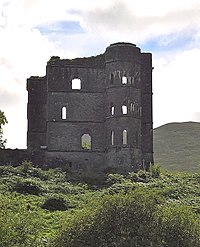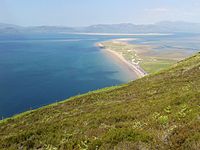Glenbeigh
| Glenbeigh Irish: Gleann Beithe | |
| County Kerry | |
|---|---|
 Glenbeigh | |
| Location | |
| Grid reference: | V671913 |
| Location: | 52°3’29"N, 9°56’16"W |
| Data | |
| Population: | 426 (2022) |
| Local Government | |
| Website: | glenbeigh.ie |
Glenbeigh or Glanbehy is a village on the Iveragh Peninsula of County Kerry. The parish includes Rossbeigh beach, Coomasahran Lake and a number of important rock art sites.
Owing to its natural heritage, history and its location on both the Ring of Kerry and the Wild Atlantic Way, Glenbeigh is a tourist destination.
The village is surrounded by a horseshoe of hills and Seefin Mountain. The Caragh and Behy rivers flow at either side of the village into Castlemaine Harbour.[1]
Name
The Irish name Gleann Beithe is from gleann "glen, valley" and Beithe, related to the Behy River (An Bheithe).[2] and the birch tree (beith).[2][3] The spelling "Glanbehy" is the official spelling for the civil parish,[4] while Glenbeigh is the spelling for the village where the N70 road meets the Behy River.[3]
History
The area around Glenbeigh has a high concentration of prehistoric open-air rock art.[5] This rock art belongs to the Atlantic tradition, consisting primarily of cup and ring marks and radial grooves, and dating back to the Late Neolithic/ Early Bronze Age period (2300-1500BC). There is an especially dense cluster near Coomasahran Lake.
A number of Fianna legends centre around Glenbeigh. These legends suggest that Diarmuid and Grainne spent some days hiding in a cave in the valley of the Behy. Nearby Rossbeigh is known for being the place where Oisin and Niamh took to the sea on their white horse to live in Tír na nÓg (the land of youth).
Near the village is the ruin of "Wynne's Folly" or "Glenbeigh Towers". This mansion was built by Lord Headley Wynne in 1867. The barbarity and brutality of Mr Roe, the agent for Lord Wynne during Land War|the evictions, were said to be far in excess of the worst actions of his master. Gladstone's Land Act of 1881, which in effect said that tenants should no longer be removed at will, did little for the residents of the Wynn Estate, as during the years of 1882 and 1883 there were numerous evictions. These evictions arose because the tenants could not afford the rent increases applied to cover the cost of construction of the castle. Not very long after this, Wynn drifted into insolvency and left Glenbeigh.
During First World War, the castle and grounds were let to the British military for use as a training centre for reservists. In 1921, Irish Republican forces burned down the castle and it was never rebuilt.
Nearby Rossbeigh Strand is a sandy beach which lies under Curra Hill. A tower at the north end of the sandhills was used once as a guide mark for ships entering Castlemaine Harbour. Badly damaged in a storm in February 2011, some of the tower's stones were salvaged and used to build a replica on Glenbeigh's main street.[6]
About the village
There are six structures included in the Record of Protected Structures:
- Glenbeigh Tower[7]
- Church of Ireland[8]
- The Towers Hotel[9]
- St James Roman Catholic Church[10]
- Glenbeigh Hotel[11]
- Cottage
Glenbeigh is close to Rossbeigh beach and mudflats, and has views across the bay to Seefin Mountain. The River Behy traverses the western village boundary, meeting Rossbeigh Creek and Lake Carragh to the north and, to the south, the lakes of Coomaglaslan and Coomasaharn. There are two candidate Special Areas of Conservation in the area.
Outside links
| ("Wikimedia Commons" has material about Glenbeigh) |
References
- ↑ "Glenbeigh and Rossbeigh". GoKerry Tourism. http://www.gokerry.ie/index.php?action=locations&location_id=99&page_id=17. Retrieved 12 July 2018.
- ↑ 2.0 2.1 An Bheithe/River Behy: Placenames Database of Ireland
- ↑ 3.0 3.1 Gleann Beithe/Glenbeigh: Placenames Database of Ireland
- ↑ Gleann Beithe/Glanbehy: Placenames Database of Ireland
- ↑ Busher O'Sullivan, Clare. "Our Ancient Landscapes: Prehistoric Rock Art in Ireland". The Heritage Council. https://www.heritagecouncil.ie/content/files/Rock-Art-Prehistoric-Rock-Art-in-Ireland-A4.pdf.
- ↑ "Volunteers recreate iconic tower in Glenbeigh village". Independent News & Media. 3 September 2016. https://www.independent.ie/regionals/kerryman/news/volunteers-recreate-iconic-tower-in-glenbeigh-village-35008628.html. Retrieved 9 June 2020.
- ↑ Glenbeigh Tower: Duchas (National Inventory of Architectural Heritage)
- ↑ Church, Glenbeigh: Duchas (National Inventory of Architectural Heritage)
- ↑ The Towers Hotel: Duchas (National Inventory of Architectural Heritage)
- ↑ Church, Glenbeigh: Duchas (National Inventory of Architectural Heritage)
- ↑ Glenbeigh Hotel: Duchas (National Inventory of Architectural Heritage)

